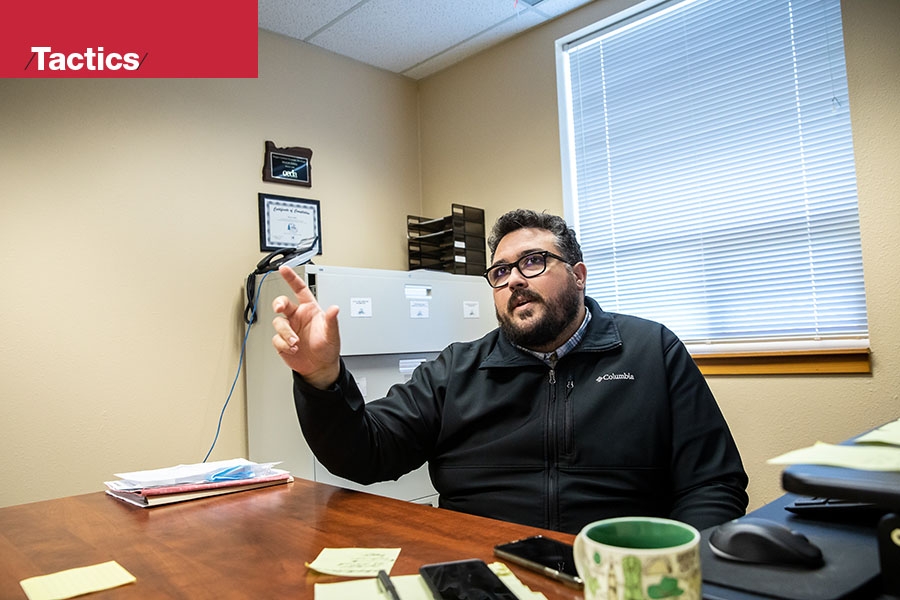Shaun Gibbs, executive director of the South Coast Development Council, talks about what’s next for the region
Shaun Gibbs came to Oregon as a trailing spouse — someone who moves for their partner’s job. Originally from California (“Don’t hold that against me”), Gibbs followed his then-partner, now-wife to Roseburg and then to Coos Bay as she pursued a career as a pharmacist.
Gibbs has a business administration degree from San Jose State University and worked for Costco for several years in college and after. But once he and his wife relocated to Coos Bay, he saw a job opening at the South Coast Development Council and decided to apply. He served as an economic development specialist for the organization for four years, then stepped into the role of interim executive director in November 2019, becoming the organization’s permanent executive director in February 2020.
The SCDC is a 501(c)(3) nonprofit organization founded in the year 2000 that acts as a “regional convener and coordinator” to bring private and public interests together on economic development projects, as well as business, retention, expansion and recruitment.
“We like to say we’re kind of that first stop for everybody, but really our niche is that traded-sector, first-stop-facilitation, economic-development org that really kind of brings everyone to the table, works on a project and helps private industry really find what they need as fast as possible, so they can be competitive and grow and come here,” Gibbs says.
This interview has been edited for length and clarity.
What does an average workweek look like for you?
It varies depending on what’s going on. There’s a lot of meetings that happen, obviously, in the region and across the communities and the state that we tap into: everything from housing to child care to talking about those foundational pieces of the region. It’s looking at new grants, working with businesses, setting up in-person meetings with businesses to see how they’re doing and making sure that they’re healthy. It’s also responding to emails about various inquiries from people looking at the region and what’s available.
Are there recent investments that you can talk about, or companies that have been talking to you that you’re able to share?
Our Port of Coos Bay is the second international port in the state of Oregon. It’s also the largest deep-water seaport, from San Francisco to the Puget Sound. And to be perfectly honest, our port’s relatively underutilized for what it is. So we’re seeing a lot of activity with the port. They recently made public a memorandum of understanding for a container-terminal development. If that’s successful, that will be a pretty substantial opportunity, not just for our local region but for the state.
We’re also seeing a lot of activity around advanced or renewable energy including offshore wind. There are also conversations around what we call future fuels — green hydrogen, ethanol and ammonia — and of what that looks like for the future of transportation and energy. A lot of the offshore wind and advanced energy conversations are being driven by the Bureau of Ocean Energy Management, which is looking at the Oregon Coast. There’s a huge natural resource of wind on the Southern Oregon Coast out here. Anyone who’s visited or lived here for a period of time, you know the wind can be tremendous.
Apart from the wind and the port, what are some of the other things that might make the South Coast an attractive place for investment?
With COVID, a lot of rural communities looked at the remote worker conversation as an opportunity to bring folks in. We’re very lucky to have a large broadband presence in our region. We have Ziply, which is expanding their network all the way through the entire region. They’ll be done, I think, in the next year or so. We also have Douglas Fast Net, which is doing the same thing. They’re doing a lot of aerial coverage of, you know, extremely fast fiber broadband access. Then there’s a utility to the south called Coos Curry Electric Co Op, and they have a broadband subsidiary called Beacon Broadband, and they’re getting up and running and they’re planning on providing fiber to every every home in their service territory in the next couple of years. That’s one thing about the Southern Oregon Coast: We are remote but we have world-class broadband and you’re at recreation’s front door. It’s not a bad place to be for the most part. It’s affordable here, and there a lot of incentives and utilities that are accessible.
It’s affordable in terms of utilities. What about the price of land?
Land costs have gone kind of crazy lately. That’s what everyone’s dealing with. But I think as far as property taxes go, or tax rates, we’re very, very affordable in our region, just because of how Oregon is set up. Our property-tax rates are some of the lowest in the state, for the most part. So building large facilities, you know, over a period of time, there’s a lot of savings there.
What are some of the challenges in terms of attracting investment?
It’s difficult to attract a widget manufacturer, because we are so far away from I-5, unless they need access to ocean resources or wooden forest products or that port infrastructure. The successes we’ve seen have been around the “blue economy”: seafood, aquaculture, boat and shipbuilding, marine shipping, and terminal development. That kind of thing is really what we see a lot of movement around.
What are some of the larger economic challenges that your region is dealing with?
Housing, like everyone. The property prices here have doubled in the past few years. A lot of it’s because of a lack of supply and a lack of building and availability. There’s also the other piece, where a lot of supply is snatched up by single-night rentals like Airbnbs, VRBOs and the tourism economy.
One of the other constraints is child care. That ties to the third issue, which is workforce. It’s really those three things: labor, housing and child care, and they are all connected. You can’t have a workforce without housing and child care, and you can’t have housing and child care without a workforce. Honestly, we’re not sure how we’re going to get through this. I think everyone’s working through it.
What are the solutions that you see? Obviously, you’re working on bringing jobs to the area. What are some of the solutions you see in terms of those other two legs of that stool?
Regionally, there’s been a push to create a housing action team in our region. It’s a loose group of city managers, some elected officials, some philanthropy-focused folks, and some others looking at housing and how to share ideas. We work with industry folks, but also, if a housing developer comes to us, we help them find what they need and make sure that they’re connected to the right people and accessing those resources.
With the child care side, there’s been some movement recently with one of our philanthropy partners at Wild Rivers Coast Alliance, and some of the others in the region, looking at how to prop up and support child care facilities. It just doesn’t pencil out to run your own child care facility anymore in Oregon; it’s really expensive. Especially in a rural community like ours, it’s just too much to deal with. There’s been some legislative movement, but we really need a bigger solution at the state level to figure out how to make this work. It’s not just for us in rural Oregon — the metro-area folks need it too.
To subscribe to Oregon Business, click here.






